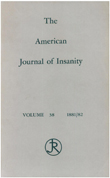Multiple personality disorder among female inpatients in a state hospital
Abstract
OBJECTIVE: Professional skepticism and concerns regarding diagnostic reliability hinder research in dissociative disorders and multiple personality disorder. The reported frequency of multiple personality disorder in different psychiatric settings ranges from 2.4% to 35%. The authors conducted a replication study of multiple personality disorder ascertainment in women admitted to a state hospital over a 5.5-month period. METHOD: Responses to the Dissociative Experiences Scale and to the Dissociative Disorders Interview Schedule were obtained, along with data on length of stay, county of admission referral, admission commitment status, and discharge diagnoses, for 176 female inpatients in a state hospital. Of 421 women representing 483 consecutive admissions, 121 were discharged before they could be assessed for study, 64 were excluded, 60 declined to participate, 176 enrolled in the study, and 175 completed the research procedures. RESULTS: Twenty- one women (12%) met criteria for multiple personality disorder based on the Dissociative Disorders Interview Schedule; these women were significantly younger than the women without multiple personality disorder. Scores on the Dissociative Experiences Scale of the women with multiple personality disorder (mean = 59.5, SD = 19.6) were significantly higher than the scores of women without multiple personality disorder (mean = 22.5, SD = 20.1), but considerable overlap occurred. There was no significant difference between groups in length of stay or admission status. CONCLUSIONS: The authors conclude that 1) the wide variability in multiple personality disorder detection is partially due to site-specific ascertainment biases and 2) despite its apparent usefulness for screening purposes, the Dissociative Experiences Scale requires more comprehensive evaluation before it can be applied broadly.
Access content
To read the fulltext, please use one of the options below to sign in or purchase access.- Personal login
- Institutional Login
- Sign in via OpenAthens
- Register for access
-
Please login/register if you wish to pair your device and check access availability.
Not a subscriber?
PsychiatryOnline subscription options offer access to the DSM-5 library, books, journals, CME, and patient resources. This all-in-one virtual library provides psychiatrists and mental health professionals with key resources for diagnosis, treatment, research, and professional development.
Need more help? PsychiatryOnline Customer Service may be reached by emailing [email protected] or by calling 800-368-5777 (in the U.S.) or 703-907-7322 (outside the U.S.).



